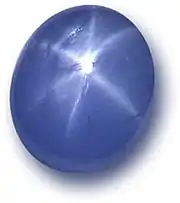Asterism (gemology)
Asterism (from Ancient Greek: ἀστήρ star), the property of a star stone (asteria), is the phenomenon of gemstones exhibiting a star-like concentration of reflected or refracted light when cut en cabochon (shaped and polished rather than faceted).

Archetype
The archetypal asteria is the star sapphire, generally corundum with near uniform impurities which is bluish-grey and milky or opalescent, which when lit has a star of six rays. In the red instance stellate reflection is rarer; the star-ruby occasionally found with the star-sapphire in Sri Lanka is among the most valued of "fancy stones". Other examples are star-topaz and certain prized chatoyant [ʃatwɑjɑ̃] (lit. cat's eye) chrysoberyl stones, particularly of the cymophane (yellow) variety.
Description
Reflection of light from twin-lamellae or from extremely fine needle-shaped acicular inclusions oriented to the stone's crystal structure causes asterism.[1] Oriented sub-microscopic rutile crystals are a common inclusion in asterism gemstones. Star-stones were formerly regarded with much superstition.[1] Pliny the Elder's example is consistent with a moonstone; he described it as a colourless stone from India within which was the appearance of a star shining with the light of the moon.[1] However, since rutile is present in most common star gemstones, these are almost never completely transparent.
An asterism is an optical phenomenon displayed by some rubies, sapphires, and other gems (e.g. garnet, diopside, spinel) of an enhanced reflective area in the shape of a "star" on the surface of a cabochon cut from the stone. Star sapphires and rubies display the property from titanium dioxide impurities (rutile) present in them.[2] The star-effect or "asterism" is caused by the difference in refractive index between the host material and that of the dense inclusions of tiny fibers of rutile (also known as "silk"). Ruutile causes the relative bright relief of a star in a host material such as corundum, which has a refractive index between 1.760 and 1.778, much lower than that of rutile. The stars are caused by the light reflecting from needle-like inclusions of rutile aligned perpendicularly to the rays of the star. The star-effect may be also caused by the inclusions of hematite. In black star sapphire hematite needles formed parallel to the faces of the second order prism produce asterism. Some Thai star sapphires may contain both hematite and rutile needles forming a 12-ray star.[3]
A distinction can be made between two types of asterism:
- Epiasterism, such as that seen in sapphire and most other gems, is the result of a reflection of light on parallel arranged inclusions inside the gemstone.
- Diasterism, such as that seen in rose quartz, is the result of light transmitted through the stone. In order to see this effect, the stone must be illuminated from behind. Rose quartz also exhibits epiasterism.
See also
References
| Wikimedia Commons has media related to Asterism (gemmology). |
-
 One or more of the preceding sentences incorporates text from a publication now in the public domain: Chisholm, Hugh, ed. (1911). "Asteria". Encyclopædia Britannica. 2 (11th ed.). Cambridge University Press. p. 792.
One or more of the preceding sentences incorporates text from a publication now in the public domain: Chisholm, Hugh, ed. (1911). "Asteria". Encyclopædia Britannica. 2 (11th ed.). Cambridge University Press. p. 792. - Emsley, John (2001). Nature's Building Blocks: An A-Z Guide to the Elements. Oxford: Oxford University Press. pp. 451–53. ISBN 0-19-850341-5.
- G., Read, Peter (2008). Gemmology (3rd ed.). London: N.A.G. ISBN 9780719803611. OCLC 226280870.
- D. S. Phillips, T. E. Mitchell and A. H. Heuer,"Precipitation in Star Sapphire I: Identification of the Precipitates, Phil. Mag. A, 1980, v. 42, N0. 3, pp 385–404